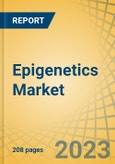Succeeding extensive secondary and primary research and in-depth analysis of the market scenario, the report studies the key industry drivers, restraints, challenges, and opportunities. The growth of the epigenetics market is driven by the rising incidence of chronic diseases due to growth in the aging population, the increasing prevalence of cancer, rising pharmaceutical R&D expenditures, the increasing focus on epigenetics in drug discovery & development, and the declining costs of genome sequencing. However, the lack of skilled professionals restrains the growth of this market.
The growing applications of epigenetics in non-oncology diseases and government initiatives supporting large-scale genomic sequencing projects are expected to generate growth opportunities for the stakeholders in this market. However, standardization concerns associated with epigenetics procedures and the limited applications of epigenetics in toxicology are major challenges to market growth.
Based on offering, the epigenetics market is segmented into kits & reagents, instruments and accessories, software and services. The kits & reagents segment is expected to grow at the fastest CAGR during the forecast period. The frequent and repetitive use of kits and reagents and the growing prevalence of chronic diseases are the major factors responsible for segment growth.
Based on method, the epigenetics market is segmented into DNA methylation, histone modification, RNA modification, polymerase chain reaction (PCR), chromatin analysis, sonication, and other methods. In 2023, the DNA methylation segment is expected to account for the largest share of the market. DNA methylation is an epigenetic mechanism that involves transferring a methyl group onto the C5 position of cytosine to form 5-methylcytosine. This process regulates gene expression by promoting or inhibiting the binding of transcription factors to DNA. Thus, it is useful in studying epigenetic changes in an organism. The increasing prevalence of cancer, technological advancements in PCR and sequencing, and the high focus on reducing costs associated with lengthy research and product approval processes support the segment’s large share.
Based on application, the epigenetics market is segmented into oncology and non-oncology. In 2023, the oncology segment is expected to account for the largest share of the market. The large market share of this segment is attributed to the high burden of cancer, the high focus on R&D regarding cancer, and the growing demand for precision oncology.
Based on end user, the epigenetics market is segmented into pharmaceutical & biotechnology companies, academic & research institutes, and hospitals & diagnostic laboratories. In 2023, the pharmaceutical & biotechnology companies segment is expected to account for the largest share of the market. The segment’s large share is attributed to the rising demand for research-related products, the increasing incidence of chronic diseases, pharmaceutical & biotechnology companies’ rising R&D expenditures, technological advancements in epigenetics, and the introduction of new epigenetics products for chronic and rare diseases.
An in-depth analysis of the geographical scenario of the epigenetics market provides detailed qualitative and quantitative insights into five major geographies: North America, Europe, Asia-Pacific, Latin America, and the Middle East & Africa, along with the coverage of major countries in each region. Asia-Pacific is slated to register the highest CAGR during the forecast period. The market growth in this region is attributed to government initiatives for genetic diseases, growing cancer incidence, rising geriatric population, rapid rise in the prevalence of chronic diseases, rising R&D spending, and increasing healthcare expenditure.
Some of the key players operating in the global epigenetics market are Thermo Fisher Scientific Inc. (U.S.), Merck KGaA (Germany), Illumina, Inc. (U.S.), Qiagen N.V. (Netherlands), New England Biolabs (U.S.), Epigentek Group Inc. (U.S.), Pacific Biosciences of California Inc. (U.S.), Bio-Rad Laboratories, Inc. (U.S.), PerkinElmer, Inc. (U.S.), 10X Genomics, Inc. (U.S.), Active Motif (U.S.), and Zymo Research Corporation (U.S.).
Scope of the Report
Epigenetics Market Assessment, by Offering
- Kits & Reagents
- Kits & Assays
- Antibodies
- Proteins & Enzymes
- Other Reagents
- Services
- Software
Epigenetics Market Assessment, by Method
- DNA Methylation
- Bisulfite Conversion
- High-resolution Melt (HRM) Analysis
- Immunoprecipitation
- Other DNA Methylation Methods
- Histone Modification
- RNA Modification
- Polymerase Chain Reaction
- Chromatin Analysis
- Sonication
- Other Methods
Epigenetics Market Assessment, by Application
- Oncology
- Non-oncology
Epigenetics Market Assessment, by End User
- Pharmaceutical & Biotechnology Companies
- Academic & Research Institutes
- Hospitals & Diagnostic Laboratories
Epigenetics Market Assessment, by Geography
- North America
- U.S.
- Canada
- Europe
- Germany
- France
- U.K.
- Italy
- Spain
- Rest of Europe
- Asia-Pacific
- China
- Japan
- India
- Rest of Asia-Pacific
- Latin America
- Middle East & Africa
Table of Contents
Companies Mentioned
- Thermo Fisher Scientific Inc. (U.S.)
- Merck KGaA (Germany)
- Illumina Inc. (U.S.)
- QIAGEN N.V. (Netherlands)
- New England Biolabs (U.S.)
- Epigentek Group Inc. (U.S.)
- Pacific Biosciences of California Inc. (U.S.)
- Bio-Rad Laboratories Inc. (U.S.)
- PerkinElmer Inc. (U.S.)
- 10X Genomics Inc. (U.S.)
- Active Motif (U.S.)
- Zymo Research Corporation (U.S.).








